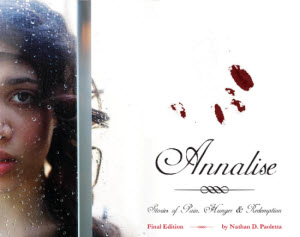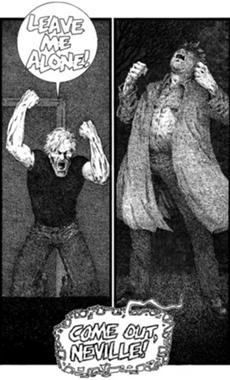You Should Be Playing…
Annalise
It always comes at the same time, night after night. It starts like an itching just under the skin in your arms, like the blood in your veins was suddenly made from crawling spiders. It was feeling you had when you would drag a knife across the skin just to feel something in the cold numbness of your adolescence, and something you had believed gone. The scars never faded, though, and when he found you, it was like your blood started crawling again. Now, you lie awake at night, waiting for the crawling to start, unable to sleep.
You stand and dress, heading out the bedroom door and passing through the living room. Your wife is sleeping on the couch because she cannot stand sharing your bed since you stopped sleeping. The part of you that still loves her more than the itching in your blood says goodbye, and you go for the closet. You pull on the jacket as the second wave hits you. He is near, now, calling to you, setting the spiders scurrying through your veins and down your back. You catch your breath and reach for the shoebox in the closet. The weight of the pistol is heavy in your hand as you remove it. With a rote action, you check the slide, chamber a round, and slip it into your jacket pocket. The old gypsy woman told you silver was the key, and you spent a small fortune getting eight shots of salvation. Maybe she told the truth. Maybe she lied. It does not truly matter that much to you. Tonight, it ends in blood. One way, or the other.
 Annalise is a cooperative storytelling game of gothic horror for two to four players. Published in 2010 by NDP Design, it was written by Nathan D. Paoletta in 2008. Two years of work went into polishing the game into its Final Design, and it is available in soft cover for $25 on the publisher’s website or online as a PDF for $10 through DriveThruRPG.
Annalise is a cooperative storytelling game of gothic horror for two to four players. Published in 2010 by NDP Design, it was written by Nathan D. Paoletta in 2008. Two years of work went into polishing the game into its Final Design, and it is available in soft cover for $25 on the publisher’s website or online as a PDF for $10 through DriveThruRPG.
Annalise is a game ultimately about telling compelling narratives of flawed, damaged people becoming the prey of a vampire. Gameplay is designed to take between three and six four hour sessions and is best run at three or four players with some experience in improvisational storytelling. Annalise is very much a game in the same style as Fiasco and Polaris, but it treads much closer to the stories of personal horror shown in Vampire: the Requiem and Don’t Rest Your Head.
In Annalise, players take on the role of the protagonists in a gothic horror story about a vampire. The game itself is tied to the styles and mechanisms gothic horror overall more so than any particular setting. As such, it is equally adept at telling a story about a psychic, invisible monster stalking a lunar colony, an ancient blood-drinking creature of the night preying on an all-girl school in the modern day, or a strange illness besetting a chivalric French countryside. Annalise resides firmly in the ur-genre of gothic horror, resisting restriction into any of its various descendants of storytelling. The elements of gothic horror – isolation, vulnerability, duplicity, and victimization – are universal throughout many other genres of storytelling. Just as vampires can be found across nearly any form of fiction, Annalise can adeptly handle nearly any setting wherein vulnerable characters can become the victim of something terrible.
Gameplay
The rules of Annalise are very light, and they serve more to guide a narrative towards a mutually interesting experience for all players than anything else. As with Fiasco and Polaris, there is no singular Game Master to run Annalise; each player at the table is expected to share in the burden of storytelling. Gameplay in Annalise begins with a discussion of the Setting by the players, establishing certain baseline ground rules for the narrative they wish to tell. This is where the game’s thematic elements are decided, along with general timelines and locations. It is important at this point to not define the characters, and especially not the Vampire central to the story. Both of those are discovered communally as the game progresses.

My name is Marvin. I am vulnerable because I’m very bored and depressed.
It is also important during this phase to establish any Veils or Lines for the story. Veils are subjects needing to be kept vague for player comfort, and Lines are elements that cannot happen in the story due to player comfort.
Once the Setting has been established, the players select someone at the table to be the first Active Player. Typically, this is someone who is not familiar with the game and has not played it before. The first Active Player has a great deal of power in setting things in motion, but also has the greatest chance of being tied to the other characters being created.
The first Active Player creates their character by giving them a name, a description, and a Vulnerability. The Vulnerability is the trait which will attract the attention of the Vampire. A character’s Vulnerability is a phrase written on a note card the player keeps in front of them, and it always begins with “I am vulnerable because…”. The rest of the phrase describes a pain, loss, or trauma that makes the character open to being victimized, and it is central to the character’s journey in the narrative. The first Active Player then narrates their character’s prologue, possibly assigning temporary roles to the other players to help introduce them and their Vulnerability. By the end of the scene, the character’s Vulnerability is known to all players, and the next player becomes the next Active Player. This player then decides a name, a description, and a Vulnerability just as the first Active Player did, but they must decide a relationship with an existing player character. For the second Active Player, this will be the first player, but other players get more options. This process repeats until all player characters are introduced.

I claim this rusty golf club.
What? It could come in handy!
During these scenes, anyone who is not the Active Player may make a Claim to an element in the narrative. Claims may be something descriptive, like “blood in the water” or “metal gleaming in firelight”, or may be a person or relationship like “Tom at the bookstore” or “abusive husband”. Claims are elements that players wish to continually bring into the story throughout the rest of the game.
During the first phase of the game, Claims can be made freely, and it is encouraged for all players to have two or three by the end of the Introductions. Claims enter play with two Coins on them, being a currency to be used later on in the game to affect the outcomes of future scenes.
Finally, once all player characters are introduced, every player writes down two Secrets. These Secrets always begin with “I can never reveal that…” and are always something dangerous or forbidden but that does not violate the Setting or any Lines or Veils. These are then dealt randomly out to the players, with each player receiving one. Once a Secret has been chosen, it may be traded with another player, but it should not be revealed. The player then splits a pool of Coins between their Vulnerability and Secret.
Facing Your Demon

You could even be legend.
After the Introduction, play continues in a round-robin storytelling format with each player taking turns driving as the Active Player. The Active Player of a scene also gets to appoint a Scene Guide, who serves as that scene’s GM. Play continues through a series of rounds as players gain more Claims, spend the Claims, gain Satellite Traits which are growths from their Vulnerability or Secret, and deal with the Vampire’s increasing hold over them and the story. The Coins on the players’ Traits and Claims serve as a dwindling currency as the game progresses, pushing the story more towards negative consequences and desperate measures.
The narrative builds into a final confrontation with the Vampire, in whatever form has been developed through the shared storytelling of the players, and the Aftermath for its survivors. With a limited amount of dice rolling involved, there is always the potential for any scene to go badly for the Active Player, with the limited resource of the Coins being the only way to mitigate it. The end of the narrative comes when the Vampire’s relationship to each character is resolved, and each character is given an Aftermath scene to showcase the scars and strengths created by their encounter.
Annalise is a game that utilizes many strategic techniques to create a sense of investment in the story. Through the use of Claims, Annalise allows the players to choose the motifs and elements which will serve to enrich their narrative, and the investment of the Coins turns the cooperative narrative into a genuine game. There is no predicting precisely how a given scene may end for the Active Player, but Claims and Coins give a player a limited power over it. With only a few truly hard and fast rules, such as to when to end the central phases of Annalise (both Laying the Foundation and Confronting the Vampire), a great deal of power is placed in the hands of the players to truly make it the game they want to have. Through the Vulnerability and the Secrets, players become invested in helping their characters overcome their weaknesses and the Vampire who preys on them. Even if the character ultimately gives in to the Vampire, the struggle alone creates a sense of catharsis and release for the player.
In the world of roleplaying games, gamers are drawn generally towards two types of experiences. The first is a sense of escapism and empowerment, of having vicarious experiences one cannot have in real life and achieving goals despite opposition. The second is a sense of immersion and catharsis, where one slips into the skin of another living, breathing character and deals with their character’s problems for a short while. Annalise is a game firmly in the second camp of experiences. Annalise invites players to experience a secondhand state of vulnerability in a controlled environment to tell a compelling story of isolation and horror, and derive from it a sense of personal growth and resolution. With its versatile, rules-light system and strategic techniques of player investment into the story, Annalise succeeds at creating a pervasive mood of turmoil, hope, and despair in a way few other games on the market can even come close to.
And that is why you should be playing Annalise.
David Gordon is a regular contributor to the site. A storyteller by trade and avowed tabletop veteran, he is always on the lookout for creative tabletop games. He can be reached at dave@cardboardrepublic.com.
You can discuss this article and more on our social media!
Photo Credits: Annalise cover by NDP Design; Marvin by BBC TV; golf clubs by Courtney Celley; I am Legend by Wikia.
